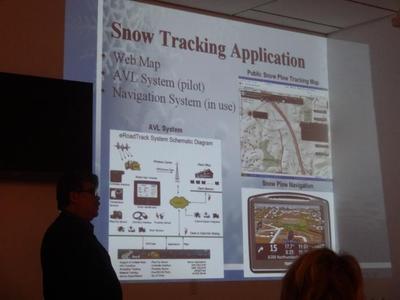



|
Montgomery County’s Winter Storm Operations and Our County Streams
Written by Ed Murtagh - January 2014
|

MC-DOT works with the County’s Department of Environmental (DEP) protection to determine the proper proportions of sand to use in the salt/sand mixes used during winter storms. The current opinion in the field is that sand has a more harmful impact on our streams than salt. Sand acts like a sediment in our streams, smothering aquatic habitat. While salt has an impact too, its impact is short-term while the sand’s impact is long-term. In addition, studies have shown that stream fish are quite tolerant of brief spikes in sodium chloride concentrations. MC-DOT, therefore, is working to reduce the amount of sand that it uses. Mr. Suprata explained that sand is still used when outdoor temperatures are especially low.
Mr. Suprata also explained how technology is being used to improve winter storm operations. Road Weather Information Sensors (RWIS) are now used in and along roads and on traffic signal poles. The RWIS, along with radio messages from police and Ride-On bus drivers, provide real-time information about road conditions. Because of the size of the county, road conditions can vary significantly from one part to another.
MC-DOT’s Salt Management Plan is an important tool in improving road safety while reducing the environmental impacts. The plan has five major elements:
MC-DOT’s Salt Brine Program is an interesting aspect of the county’s operation. Salt brine is liquid (rather than crystal) form of sodium chloride. Brine can be sprayed ahead of a winter storm to reduce bonding of ice and snow on the roads. Once bonding occurs, it is difficult to remove the ice from the roads. In addition, while salt loses its effectiveness at 20 °F, the brine works down to -6 F. In Montgomery County, brine is typically applied to over 900 lane miles of primary and secondary routes. This program helps reduce the amount of salt used and thus the amount entering our ecosystems.
While useful, brine is not a perfect solution. A sleet and rain mix will wash the salt brine away. While MC-DOT has worked over the years to reduce the amount of salt used per lane-mile, the number of lane-miles in the county has steadily increased. If we are ever going to see our streams restored to ecological health, MC-DOT will need to continue working to discover and use less impactful techniques and materials.